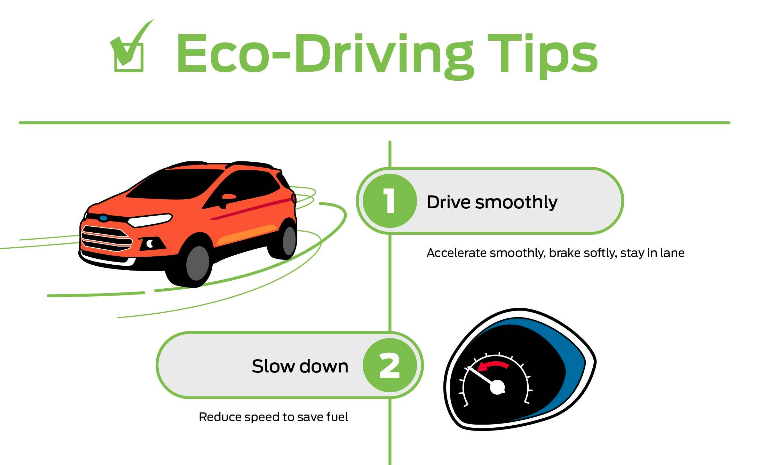
Hands up, who likes forking out cash to fill up at the fuel station? What if you could do that less often? Where would you turn for help?
Try turning to the mirror, because poor driving habits are just like pouring money down the drain. As consumers buy fuel efficient vehicles in record numbers to save money and benefit the environment, few know that good driving habits are really the best way to economize.
In a recent survey by Ford Motor Company, Indian drivers were asked about their driving habits and fuel efficiency knowledge. When asked about their driving habits, 95 percent claimed they knew how to drive their car for maximum fuel efficiency, and 96 percent said they make a concerted effort to drive efficiently on a daily basis. The survey covered 9,500 drivers across 11 markets in Asia Pacific, including 1,023 Indian respondents.
Ford studies have investigated the influence of driving style on fuel consumption and CO2 per kilometer driven and found that by adopting an eco-driving style, drivers can slash both their fuel bill and their emissions by as much as 25 percent compared with ‘normal-average’ driving behavior. Small changes to the way you drive can have a big impact on fuel economy.
People go to extraordinary lengths to save money but then they jump in their cars and waste fuel,
said Adam Smith, Vehicle Energy Management Engineering Manager and one of Ford’s top fuel efficiency experts in Asia Pacific.
Eco-driving not only saves you fuel and money, it also benefits the environment and can make our roads safer for everyone.
Here are some simple tips that can help you be a greener, more fuel efficient driver:
Drive smoothly
Aggressive driving such as rapid acceleration, speeding and braking can lower your fuel mileage significantly. So accelerate smoothly, brake softer and earlier, and stay in one lane while it’s safe to do so. Not only do these driving techniques save fuel, they can prolong the life of your brakes and tires.
Slow down
Speeding wastes lots of fuel. By driving 90km/h instead of 100km/h you can improve your fuel efficiency by up to 10-15 percent. Also, aim for a constant speed. Pumping the accelerator sends more fuel into the engine, emptying the tank faster. Using cruise control whenever possible on the highway helps maintain speed and conserve fuel.
No idling
Today’s engines don’t need a warm up. Start the car immediately and gently drive away. Don’t leave your car idling. Prolonged idling increases emissions and wastes fuel. Turn the engine off whenever it is safe to do so, such as when stationary for more than 30 seconds. This avoids unnecessary energy consumption of an idle running engine.
Remove unnecessary cargo
Reducing the amount of cargo you keep in your trunk or back seat can improve your fuel efficiency as less energy is needed for acceleration. Try to travel as light as possible, keep only the most important items (like an emergency kit, jumper cables, a small toolset, and a small jack) in the vehicle.
Reduce aerodynamic drag
Your vehicle is designed for good aerodynamics – but attaching a huge carrier or bike to the roof adds more wind resistance. If you spend lots of time on the highway or are planning a long trip, try to transport extra items inside the vehicle or attached to the rear. Keeping your windows and sunroof closed can lower wind resistance too. You will have less drag, and better fuel economy.
Only use A/C on the highway
Your fuel economy drops by up to 15 percent when you use the air conditioner at low speeds. So if it isn’t too hot, turn off the air conditioner when driving around town, and roll down your windows instead. However, at 90km/h or higher, using the air conditioner is preferable to open windows for two reasons: Your vehicle has much lower wind resistance with the windows closed. And because the engine produces more power at higher revs, it’s able to run accessories like the A/C compressor more efficiently.
Use cruise control
Activating your cruise control keeps you from mindlessly driving faster and with lower fuel efficiency, maintains a constant speed, and won’t use additional fuel while accelerating. Try to set your cruise control at your vehicle’s most fuel-efficient speed, as long as it’s at or below the legal limit.
Combine trips
Many short trips will use more fuel than a single, longer trip. So when you have to drive for errands, get as many accomplished as you can in one trip to maximize your fuel economy.
Watch Ford’s ‘How to save money on fuel’ video here:
[responsive_youtube https://www.youtube.com/watch?v=2sEsTMzSRfM]
You can add more to this story by commenting below.







